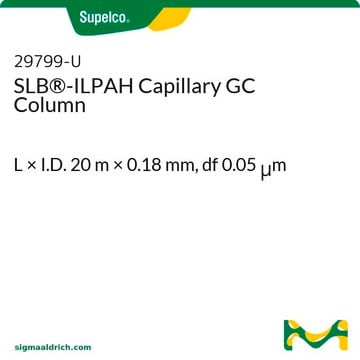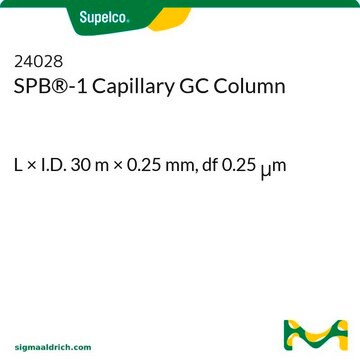Transportation information can be found in Section 14 of the product's (M)SDS.To access the shipping information for this material, use the link on the product detail page for the product.
28469-U
Coluna de GC capilar SLB®-5ms
L × I.D. 15 m × 0.25 mm, df 0.25 μm
About This Item
Produtos recomendados
Materiais
fused silica
Agency
Standard Method 6040D
EN 2005/108/EC
EPA 610,625,8015,8082,8100,8141,8270,OLM04.2 SVOA
EPA TO-13,IP-8,8270,525.2,608.1/608.2,608/8081/OLM04.2 PEST
JMHLW
NIOSH 2530,5503
OSHA 62
meets requirements for USP G27 and G36
suitable for EPA 1613
conformidade reg.
FDA LIB 4423
Parâmetros
-60-340 °C temperature (isothermal)
-60-360 °C temperature (programmed)
Valor beta
250
df
0.25 μm
técnica(s)
GC/MS: suitable
gas chromatography (GC): suitable
C × D.I.
15 m × 0.25 mm
Grupo ativo da matriz
Bonded and highly crosslinked; silphenylene polymer virtually equivalent in polarity to poly(5% diphenyl/95% dimethyl siloxane) phase
aplicação(ões)
agriculture
chemicals and industrial polymers
cleaning products
clinical
cosmetics
environmental
flavors and fragrances
food and beverages
forensics and toxicology
industrial hygiene
life science and biopharma
personal care
petroleum
pharmaceutical (small molecule)
tipo de coluna
capillary non-polar
Procurando produtos similares? Visita Guia de comparação de produtos
Categorias relacionadas
Descrição geral
Código da USP: Esta coluna atende aos requisitos da G27 e G36 da USP.
Fase:
- Ligada e altamente reticulada
- Polímero de silfenileno praticamente equivalente em polaridade ao poli(difenil 5%/dimetilsiloxano 95%)
- ≤D.I. de 0,32 mm: -60 °C a 340 °C (isotérmica) ou 360 °C (programada)
- ≥D.I. de 0,53 mm: -60 °C a 330 °C (isotérmica) ou 340 °C (programada)
Outras notas
Informações legais
solvente
Escolha uma das versões mais recentes:
Já possui este produto?
Encontre a documentação dos produtos que você adquiriu recentemente na biblioteca de documentos.
Artigos
The analysis of melamine and related compounds in dog food with the use of more economical gas chromatography-mass spectrometry (GC-MS) instrumentation.
Conteúdo relacionado
This page is intended to make it easier to find the consumables you need based on the analytical method you’re using. Methods included on this page come from the EPA, Standard Methods and ASTM.
-
What is the Department of Transportation shipping information for this product?
1 answer-
Helpful?
-
-
What if my method does not allow me to change to SLB™-5ms Capillary GC Columns?
1 answer-
These methods typically specify a 5-type column (DB-5 or equivalent). The SLB-5ms satisfies that requirement.
Helpful?
-
-
What are the benefits of the SLB™-5ms Capillary GC Column over other manufacturers’ -5ms columns?
1 answer-
The SLB-5ms excels in several performance criteria.· Low Bleed. The highly crosslinked silphenylene polymer chemistry reduces column bleed to a very low level, resulting in greater signal-to-noise level, allowing lower detection levels.· Inertness. The proprietary surface deactivation reduces interactions between analytes and the column surface, resulting in sharper peak shapes, allowing lower detection levels.· Durability. With the highest published maximum allowable operating temperature (MAOT) of any -5ms column, SLB-5ms columns are designed for long life.· Consistency. Innovative manufacturing processes result in decreased column variability, ensuring that the next column is as good as the last.
Helpful?
-
-
Who uses SLB™-5ms Capillary GC Columns?
1 answer-
Any analyst with the need for a non-polar column. Some applications include boiling point separations, GC-MS analyses of semivolatiles, and GC-ECD analyses of pesticides/PCBs. It is estimated that non-polar columns account for 51% of the worldwide column market.
Helpful?
-
-
Would you recommend SLB™-5ms Capillary GC Columns for all applications instead of Equity-5, SPB-5, PTE-5, MDN-5, and MDN-5S?
1 answer-
Yes.
Helpful?
-
-
How does the SLB™-5ms Capillary GC Column differ from our other 5-type columns?
1 answer-
Many of our other 5-type columns (Equity-5, SPB-5, PTE-5, MDN-5, and MDN-5S) incorporate a siloxane polymer (backbone comprised of Si and O atoms only, side groups are either methyl or phenyl). The SLB-5ms column incorporates a silphenylene polymer (backbone comprised of Si and O atoms plus some phenyl groups, side groups are either methyl or phenyl).
Helpful?
-
Active Filters
Nossa equipe de cientistas tem experiência em todas as áreas de pesquisa, incluindo Life Sciences, ciência de materiais, síntese química, cromatografia, química analítica e muitas outras.
Entre em contato com a assistência técnica



